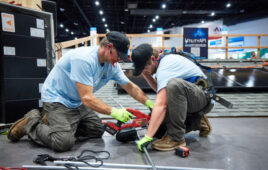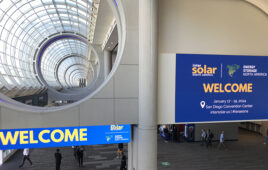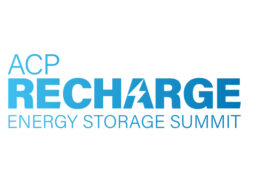At the Spartan Superway Project test track at Intersolar North America, a model pod was experiencing trouble. Intended to demonstrate how a solar-powered pod – resembling a small, caboose-like cabin – hanging from an elevated guide-way could swiftly transport passengers through a city, a loose wire had interrupted power to one of the motors and put demonstrations on hold.
 Lacking solder and an iron to make a proper repair, student Ryan Luc devised a connection with electrical tape and copper.
Lacking solder and an iron to make a proper repair, student Ryan Luc devised a connection with electrical tape and copper.
The Spartan Superway Project is a multi-disciplinary team of student engineers, designers and urban planners at San Jose State University. The group envisions cities where on-demand, elevated transport alleviates traffic congestion and gets people to destinations faster – and all of it would be powered by renewable energy.
“We run a risk of shorting,” Luc said, tool in hand, trying to finagle wire through an opening at the top of the pod, a 1/12-scale model. As it sat on the table, with wifi-card, motherboard and motors visible, it resembled Rosie, the robot from The Jetsons.
Student John Fidel, watching Luc’s progress, would prefer the model hang from the track, resembling the future of transportation. “Whatever connects it,” he said.
The Spartan Superway Project’s booth, which is located toward the rear of the first floor of Moscone West, resembles the garage of a startup. Transparent rail structures, adorned with obscure notes and directions, twist and turn for at least 50 feet, held up by pipes at head-level. Nearby, a mock-up of a full-size pod hangs from a rail made of wood, topped with solar panels.
 The display gives an impression that an Automated Transportation Network, or ATN, such as the one Spartan imagines, is far from realization. Adding to popular skepticism is “monorail salesmen,” a stereotype for corporations that peddled big ideas without engineering to back them up. When projects failed to meet expectations, innovative ideas were dismissed. Cities kept the car, the bus, the subway, the light-rail, despite up to 30 companies inventing transport like the Superway, starting with Boeing in the 70s, that could be more efficient.
The display gives an impression that an Automated Transportation Network, or ATN, such as the one Spartan imagines, is far from realization. Adding to popular skepticism is “monorail salesmen,” a stereotype for corporations that peddled big ideas without engineering to back them up. When projects failed to meet expectations, innovative ideas were dismissed. Cities kept the car, the bus, the subway, the light-rail, despite up to 30 companies inventing transport like the Superway, starting with Boeing in the 70s, that could be more efficient.
The people at the Spartan Superway Project retain hope that a new generation of commuters, planners and engineers will be open to new ideas once again. A large crew of young people had gathered Wednesday to help spread the word about the Superway to booths across Intersolar.
“Just because some prototypical installations installed 20 years ago didn’t work doesn’t mean we shouldn’t innovate public transportation,” said Sam Ellis, a project manager at the International Institute of Sustainable Transportation.
Some places are already open to innovation. Personal Rapid Transit, or PRT, is commercially implemented in a South Korean tourist attraction called Suncheon Bay. PRT serves as a subway car on demand, and is used in areas where the demand for transport systems is irregular and high during peak hours. PRT provides low noise, comfortable and environmentally considerate transport for three million tourists annually.
The South Korean project is a lot like the Spartan Superway project, but without solar. Ellis says the Spartan project is powerable in its own footprint. He says a two-meter-wide solar panel running the length of the guide-way could power more than 5,000 vehicles an hour, each weighing 2,000 lbs. loaded with passengers.
So why hasn’t the idea been implemented in the U.S.?
“It’s the first telephone problem,” Ellis says. “The first person with a phone didn’t have anyone to call. Original networks are limited.”
But the organization plans to build a 150-yard, full-scale test track next year. Upon seeing that, it believes corporations and governments will be encouraged to adopt and develop the technology. Representative from every Silicon Valley city have had meetings to discuss the Superway, Ellis said.
 And the project is making a buzz at Intersolar, too.
And the project is making a buzz at Intersolar, too.
Emily Hanlon, a graduate student at San Jose State interning at SnapNrack, says news of the pod track had traveled three floors up to the SnapNrack booth.
“What’s incredible about the project is the collaboration between departments,” Hanlon said. “It’s getting student involved in solar and technology in a way that’s fresh and requires critical thought.”
Six Steps To A Solar-Powered Superway
1. Control system
A control system wirelessly directs cars equipped with on-board sensors for object detection, acceleration, velocity and position.
2. Guide-way and bogie switch
Switching is implemented in the drive train of individual pod cars to facilitate frequent directional changes.
3. The cabin
A cabin is suspended from the guide-way and can travel at over 50 mph.
4. Fare-box mobile phone app
An app enables instant scheduling, navigation and ticketing.
5. Solar power
Photovoltaic panels are designed to be the primary source of power for the system.
6. Collaboration
Private and public sectors have vested interests and economic analyses are underway to assess revenue potential.




Tell Us What You Think!